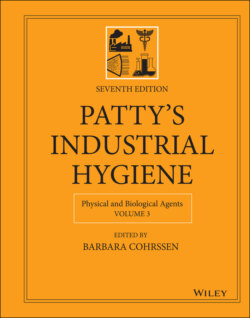Читать книгу Patty's Industrial Hygiene, Physical and Biological Agents - Группа авторов - Страница 144
6.6 Dental Curing and Bleaching
ОглавлениеBoth UV light and short‐wavelength visible light are used in dentistry for curing resins in composite fillings and for tooth whitening treatments. Light is used to activate photoinitiators, which initiate polymerization of the resin. Photoinitiators can be activated by radiation only in specific bands; for example, the commonly used photoinitiator camphoroquinine has an activity peak between 470 and 480 nm. Photocuring units use halogen lamps, LEDs, plasma‐arc lamps, or lasers, and produce irradiance levels that range from 3000 to over 10 000 W m−2 (87). The duration of irradiation is typically just a few minutes for curing but may last up to an hour for bleaching. Dental personnel is at risk from exposure to radiation reflected from the patient's teeth. Calculations of the maximum permissible exposure time to blue‐light radiance from 26 models of dental lamps indicated that the blue‐light dose could be exceeded in several seconds or several minutes, depending on the type of lamp (88).
In an evaluation of the spectral transmittance of 18 different filters used in protective eyeglasses, handheld filters, or stationary filters for dental curing or bleaching lights, it was found that nine of the filters had transmittance less than 0.1% in the blue‐light region and would provide adequate attenuation when used with any dental lamp on the market. Six of the filters were found to provide inadequate protection if used with the lamps for which they were recommended (88).
